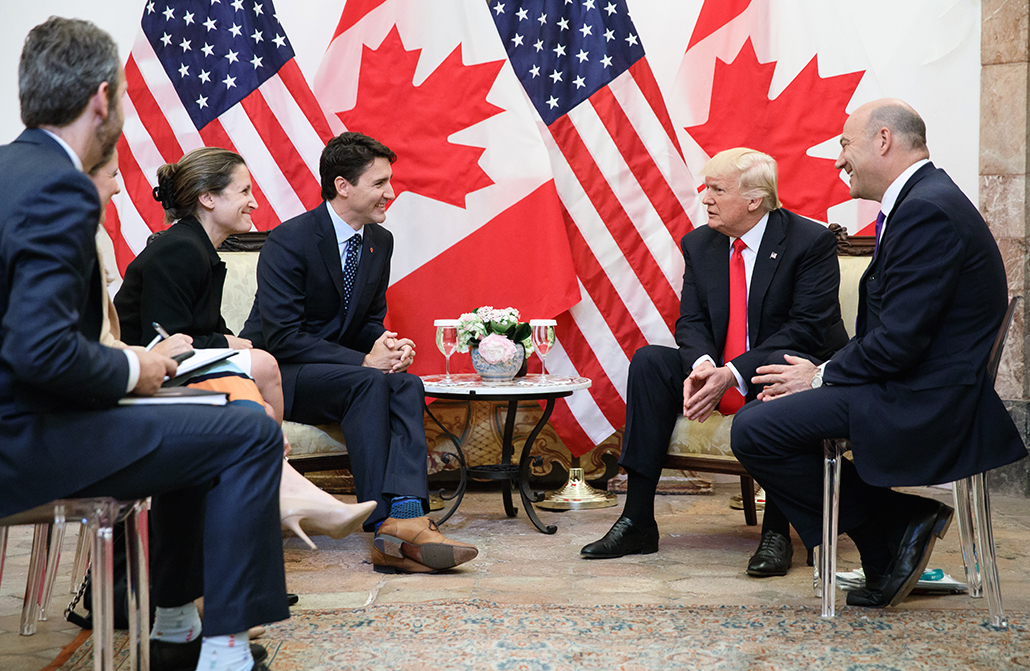Following his departure from the Charlevoix G7 Summit, Donald Trump took to Twitter to denounce the host, Canadian Prime Minister Justin Trudeau, calling him weak and very dishonest.
The U.S. president was angry because Trudeau said it was “sort of insulting” to cite national security as the reason for imposing new U.S. tariffs on Canadian imports of aluminium and steel, since soldiers from both countries had fought shoulder to shoulder on various occasions around the world since the First World War.
Trump claimed it was Canada that blocked U.S. goods, with tariffs as high as 270 per cent on U.S. milk, suggesting the American tariffs were pressure tactics unrelated to national security.
Being name-called by Donald Trump will likely result in boosting the flagging popularity of the Canadian prime minister, if not his government.
Virtually all Canadian leaders came out in support of Justin Trudeau, including Ontario premier-elect Doug Ford, Alberta Opposition Leader Jason Kenney (who has spent his career attacking Trudeau) and, in an interview with Fox News, former PM Stephen Harper.
Trudeau can take solace from Pew opinion polling that one year ago revealed only 22 per cent of Canadians thought Trump was up to the job. The same source showed 83 per cent of Canadians had exhibited confidence in U.S. president Barack Obama when he occupied the White House.
Team Trudeau can sit back and let Canadians treat the Trump Twitter tirade as the latest example of Trump being Trump. Watching the U.S. president use social media to draw attention to himself and diminish his adversaries, real or imagined, is a daily feature of his presidency. However, the Trump tweets reveal problems ahead for Canada-U.S. trade relations, and his threats need attention.
The Canadian strategy of responding to U.S. import tariffs of 10 per cent on aluminium shipments and 25 per cent on steel was to announce a set of retaliatory Canadian tariffs on American imports. These are designed to draw the attention of key U.S. legislators and drew the approval of Gordon Ritchie, the one-time deputy chief negotiator of the 1988 Canada-U.S. bilateral trade agreement.
The problem with the Canadian strategy is that Canadian exporters are more dependent on the U.S. market than American exporters are on the Canadian market. Canadian retaliatory tariffs, while annoying, are not going to damage U.S. industry.
U.S. tariffs, on the other hand, can cause a lot of trouble to Canada. While the steel trade between Canada and the U.S. is balanced, with about US$5 billion going each way across the border, since Canada exports 50 per cent of all steel production to the U.S., the new 25 per cent U.S. tariff hits one-half of the industry. Meanwhile the Canadian tariff only affects 5-6 per cent of U.S. steel production since the U.S. exports only about 12 per cent of the steel it produces (one-half to Canada).
Just how much damage the U.S. can do to Canada’s major export industry is something Justin Trudeau and Doug Ford are going to find out when the U.S. imposes an expected 25 per cent tariff on Canadian automotive exports.
It is precisely this ability to do damage that led the Mulroney Conservative government to pursue a free trade agreement (FTA) with the U.S. in the 1980s. Unfortunately, in the 1988 FTA the Conservatives, who had oversold the benefits of a free trade deal, folded under pressure, and allowed the U.S. to continue to use all its protectionist laws. Though the agreement Mulroney first signed 30 years ago, like NAFTA was labelled as “free trade,” it left the country vulnerable to exactly what is transpiring today: American protectionist tariffs.
Trudeau expects to combine with other nations to act against U.S. exports, using World Trade Organization (WTO) rules, rather than NAFTA, to exert pressure on Trump. All WTO members are potential allies since all face U.S. protectionist action.
Since U.S. exports remain small relative to the domestic economy at 12 per cent of GDP (compared to Canada at 32 per cent of GDP) it is not easy to get the attention of Americans with retaliatory tariffs, even when they are applied by major trading partners like the EU and Mexico as well as Canada. However, co-ordinated targeted tariffs can hurt key U.S. manufacturing sectors.
Official Ottawa needs to recognize that Canada is better off working with other countries to build a reasonable multilateral trading world rather than depending on the goodwill of a Donald Trump to re-negotiate NAFTA, or betting that he will not be re-elected.
It is past time for Canada to return to active support for improved multilateral trade arrangements instead of the Harper/Trudeau policy of pursuing bilateral or regional agreements.
Duncan Cameron is president emeritus of rabble.ca and writes a weekly column on politics and current affairs.
Photo: Adam Scotti/PMO




